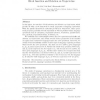Free Online Productivity Tools
i2Speak
i2Symbol
i2OCR
iTex2Img
iWeb2Print
iWeb2Shot
i2Type
iPdf2Split
iPdf2Merge
i2Bopomofo
i2Arabic
i2Style
i2Image
i2PDF
iLatex2Rtf
Sci2ools
TCS
2011
2011
Block insertion and deletion on trajectories
In this paper, we introduce block insertion and deletion on trajectories, which provide us with a new framework to study properties of language operations. With the parallel syntactical constraint provided by trajectories, these operations properly generalize several sequential as well as parallel binary language operations such as catenation, sequential insertion, k-insertion, parallel insertion, quotient, sequential deletion, k-deletion, etc. We establish some relationships between the new operations and shuffle and deletion on trajectories, and obtain several closure properties of the families of regular and context-free languages under the new operations. Moreover, we obtain several decidability results of three types of language equation problems which involve the new operations. The first one is to answer, given languages L1, L2, L3 and a trajectory set T , whether the result of an operation between L1 and L2 on the trajectory set T is equal to L3. The second one is to answer, ...
| Added | 15 May 2011 |
| Updated | 15 May 2011 |
| Type | Journal |
| Year | 2011 |
| Where | TCS |
| Authors | Bo Cui, Lila Kari, Shinnosuke Seki |
Comments (0)

